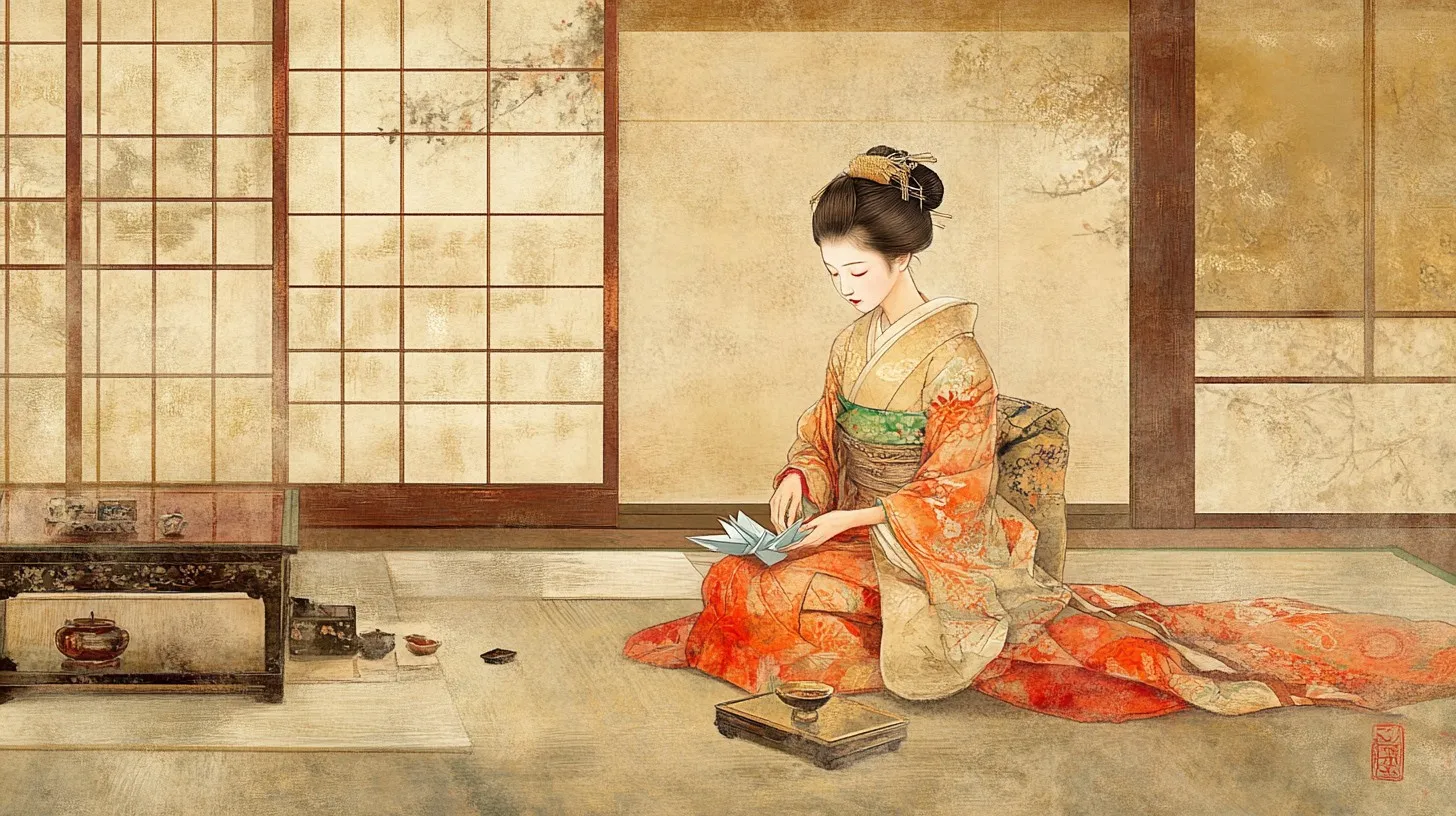Almost everyone can fold a paper airplane or a paper boat. Some can even fold a shirt with a tie in front of friends. It's fun and shows how skillful one can be with their fingers and what abilities they have. Let's find out together what Origami is, when it originated, became popular, and why it's true art. Origami is an art that teaches us patience, precision, and the ability to see beauty in small things. Through Origami, we discover the world and ourselves, develop creative thinking, and fine motor skills. Let's delve into the definition of this term and explore the history of this art, which is over 1000 years old.
Origami: Definition
Origami (jap. 折り紙) is an ancient Japanese art of paper folding without the use of scissors or glue. The word "Origami" itself consists of two Japanese roots: "ori" (fold) and "kami" (paper). In different cultures, there are their own names for this art. In Korea, for example, it is called "jongi-jeobgi," which also means "paper folding." In Spain and Latin American countries, the term "papiroflexia" is used, while in English-speaking countries, the Japanese "origami" has become established.
Origami is an art form that requires precision, patience, and spatial thinking. Each fold, each bend of the paper has a meaning and leads to the creation of the final shape. From simple figures that children can fold to complex models created by masters, Origami encompasses a wide range of complexity and beauty.
Despite the differences in names and cultural contexts, the essence of Origami remains unchanged - it is the art of transforming a flat sheet of paper into a three-dimensional figure through folding. It is an art that combines mathematical precision and artistic vision, tradition and innovation.
The History of Origami
Ancient China: The Birth of Paper (until the 7th century AD)
In ancient China, tired of uncomfortable wooden and bamboo tablets and expensive silk and wool, paper made from mulberry tree bark and bamboo was invented by the 3rd century BC. Officially, the emperor was only informed of this technology in 105 AD. Paper was used for writing, religious purposes, and daily life, such as for the famous hanging lanterns.
Introduction to Japan: The Seed of Origami (7th-12th century)
Despite China's efforts to keep the secret of papermaking, the wandering Buddhist monk Dan Ho brought this knowledge to Japan in the 7th century. This is reported in the "Japanese Chronicles" (Nihongi). In Japan, paper found widespread use in everyday life: it was used to make room dividers, windows, umbrellas, and clothing elements. It played a special role in Buddhist rituals.
Philosophical Reflection: Fusion with Buddhism and Shinto (8th-12th century)
During this period, the philosophical foundation of Origami was formed. Japanese Zen Buddhism sought truth in the beauty of each moment, in fragility and transience. Shintoism brought the idea of the presence of a deity (Kami) in everything, especially in the unusual. Thus, Origami (jap. 折り紙, folded paper) emerged as an art full of deep meaning.
Aristocracy Era: Origami at Court (1185-1573)
In the Kamakura and Muromachi periods, Origami became an art and entertainment for the aristocracy. The ability to fold elegant figures was considered a duty for courtiers. Notes and letters were often folded in the form of butterflies, cranes, or intricate figures to express good wishes and feelings.
Democratization of the Art: Origami for All (1573-1867)

In the Azuchi-Momoyama and Edo periods, paper became more accessible, and Origami spread among the common people. Many new figures were created that became classics, such as the crane Tsuru - a symbol of luck and longevity.
Systematization and Dissemination: The First Origami Books (Late 18th - Mid-19th Century)
In 1797, "Senbazuru Orikata" (How to fold a thousand cranes) was published, describing 49 crane models related to the legend of wish fulfillment. In 1845, "Kan no mado" (Window in the middle of winter) was released, presenting even more diverse figures. Origami finally became a pastime accessible to all levels of society.
Modern Origami
The development of origami in the 20th and 21st centuries is closely associated with the name Akira Yoshizawa. This Japanese master made an invaluable contribution to popularizing and further developing the art of paper folding.
Akira Yoshizawa was born in 1911. In his youth, he worked as a technical draftsman in a factory and taught descriptive geometry. These skills later played an important role in his approach to origami. After World War II, in 1952, something happened that changed Yoshizawa's life and the history of origami. The magazine "Asahi Graph" published photos of his figures, bringing the master great renown.

After becoming famous, Akira Yoshizawa dedicated his life to the development and popularization of origami. He published 18 books on this art, making it accessible to a wider audience. His most important contribution was the development of a system of symbols for folds and actions in creating figures. This system, which requires no translation, is still used by origami artists around the world today.
It is noteworthy that it was a teacher of descriptive geometry who developed such a universal system of symbols. This shows how Yoshizawa's past experiences helped him systematize and simplify the complex art of origami.
For his contribution to the development of Japanese culture, Akira Yoshizawa was honored with Japan's highest award - the Order of the Rising Sun. He passed away in 2005 at the age of 94, leaving behind a rich legacy.
Yoshizawa's legacy includes his books, the system of symbols, hundreds of original models, as well as a philosophical approach to origami that combines mathematical precision and artistic vision. His works continue to inspire origami artists around the world, and his teaching methods and symbol system remain the foundation for learning origami.
Origami Today
In our time, origami has surpassed the boundaries of a simple hobby and is being applied in various fields of life and sciences.
Origami is often used as an element of festive decoration and entertainment in various countries. The art of paper folding has become a popular hobby that attracts people of all ages through its accessibility and the ability to create beautiful objects from a simple sheet of paper.
In psychology and medicine, origami has found application as a form of art therapy. This method helps people deal with anxiety and anger, promotes concentration, and contributes to relaxation. In working with children, origami is used to develop fine motor skills, spatial thinking, and reduce emotional tensions. Speech therapists use origami techniques in their practice to improve children's language skills.
The principles of origami have found unexpected applications in engineering. In medicine, aerospace, and mechanical engineering, foldable structures inspired by origami are used. Examples include foldable stents for cardiovascular surgery or compact solar panels for spacecraft.
From a mathematical perspective, origami presents an interesting area of research. The goal of the origami artist is to precisely determine the position of one or more points on the sheet that define the folds necessary to create the final object. This leads to complex geometric tasks.
Of particular interest are the Huzita axioms - a set of seven rules that formally describe geometric constructions with flat origami. These rules can be compared to classical constructions with compass and straightedge, even surpassing them in some aspects of their capabilities.
Origami continues to evolve as art, science, and educational tool. It teaches patience, precision, develops spatial thinking, and creativity. From simple figures that a child can fold to complex mathematical models and engineering solutions, origami proves that a simple sheet of paper can hold infinite possibilities for creativity and innovation.
Postscript
As a father, I regularly fold origami with my 10-year-old son. I like that my son can draw the following important conclusions through numerous attempts:
- A beautiful figure is created only through careful and precise folding. A single inaccurately made crease - and the figure is no longer perfect. (Attention to detail and care are important to achieve an excellent result)
- One must follow a specific set of directions that must be remembered. Normally, a moderately complex figure consists of about 50 steps. (It is important to follow instructions and remember the sequence of steps)
- Haste leads to nothing - it is better to fold slowly but correctly, than to hurry, make a mistake, and start over. Here one remembers the popular saying: "Haste makes waste". (Patience and care in work often lead to better results than haste)
- If it doesn't work on the fifth attempt, one must try it ten times. Talent and natural abilities make up only 2% of success, the remaining 98% is practice. (Persistence and constant practice are the keys to mastery)
Furthermore, origami excellently develops fine motor skills. I can help my son acquire knowledge at school and get into university, but the head is his own. And if he does not want to work with his head in life, he can at least become an excellent pastry chef!
As an example, here is a video of him folding an Origami Shuriken Star.

